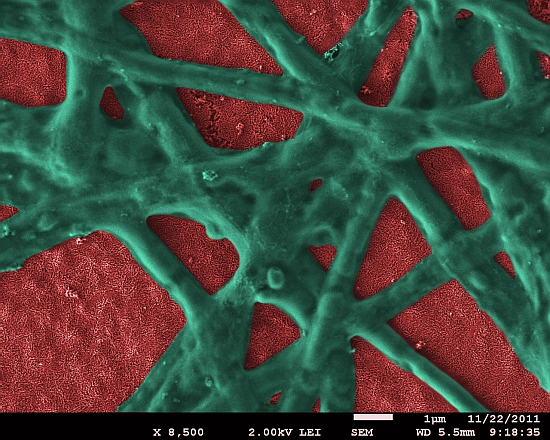Towards artificial photosynthesis for solar hydrogen generation
Algal protein gives boost to electrochemical water splitting

| Hematite nanoparticle film (red) with functional phycocyanin network (green) attached. (Image by Dr. E. Vitol, Argonne National Laboratory) | ||
| Photosynthesis is considered the «Holy Grail» in the field of sustainable energy generation because it directly converts solar energy into storable fuel using nothing but water and carbon dioxide (CO2). Scientists have long tried to mimic the underlying natural processes and to optimize them for energy device applications such as photo-electrochemical cells (PEC), which use sunlight to electrochemically split water – and thus directly generate hydrogen, cutting short the more conventional approach using photovoltaic cells for the electrolysis of water. | ||
| Traditionally, PEC electrodes are made of semiconducting materials such as metal oxides, some of which are also known for their photocatalytic properties. For quite some time, researchers at Empa’s Laboratory for High Performance Ceramics (LHPC) have been investigating nanoparticles of these materials, for instance titanium dioxide (TiO2), for the neutralization of organic pollutants in air and water. Collaborating with colleagues at the University of Basel and at Argonne National Laboratory in the US, they now succeeded in making a nano-bio PEC electrode, consisting of iron oxide conjugated with a protein from blue-green algae (also known as cyanobacteria), which is twice as efficient in water splitting as iron oxide alone. | ||
| Inspired by photosynthesis | ||
| The second ingredient in the novel electrode «recipe» is phycocyanin, a protein from blue-green algae. «I was inspired by the natural photosynthetic machinery of cyanobacteria where phycocyanin acts as a major light-harvesting component. I wanted to make artificial photosynthesis using ceramics and proteins», recalls Debajeet K. Bora who designed the new electrode during his PhD thesis at Empa. «The concept of hematite surface functionalization with proteins was completely novel in PEC research.» | ||
| After Bora covalently cross-coupled phycocyanin to hematite nanoparticles that had been immobilized as a thin film, the conjugated hematite absorbed many more photons than without the algal protein. In fact, the induced photocurrent of the hybrid electrode was doubled compared to a «normal» iron oxide electrode. | ||
| One tough cookie | ||
| The project was fully funded by the Swiss Federal Office of Energy (SFOE). Bora who will soon have completed his PhD thesis says he will continue what he started at Empa during a postdoc at the University of California, Berkeley, which he will assume early next year. | ||
| ||||
| ||||
| ||||
| ||||
